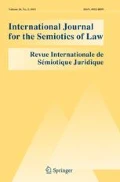Abstract
Terrorist organisations have increased and widened in Iraq in particular and the world in general in recent years. People have suffered a lot from these terrorist organisations due to their thirst for killing innocent civilians. The study aims to convey the suffering of innocent Iraqis caused by terrorist acts to the world. In order to achieve the aim, the research adopted Barthes’s (1964) framework to analyse the selected photographs. The researchers have selected (13) iconic photographs for the analysis. The photographs are taken from the main websites of the local, Arabic, and foreign media. The study found out that terrorism is the brutal enemy of all Iraqi societies including Sunnis, Shia, Kurds, Christians, and Yazidis. This research is a clear example that shows the world the extent of the suffering, pain, and fear Iraqi people are facing because of terrorism.

Adapted from “The Semiotic Analysis of Trademark Law”, by B. Beebe, 2004, UCLA Law Review, 51(3), P. 637. Copyright 2004 by Barton Beebe. Reprinted with permission

Adapted from Semiotics: The Basics (p. 14), by D. Chandler, 2007, London and New York: Routledge. Copyright 2007 by Daniel Chandler. Reprinted with permission

Reprinted from Routledge Critical Thinkers: Roland Barthes (p. 42), by G. Allen, 2003, New York: Routledge. Copyright 2003 by Graham Allen. Reprinted with permission
Similar content being viewed by others
References
Allen, G. 2003. Routledge critical thinkers: Roland Barthes. New York: Routledge.
Barthes, R. 1964. Elements of semiology. New York: Hill and Wang.
Beebe, B. 2004. The semiotic analysis of trademark law. UCLA Law Review 51(3): 621–704.
Bilal, A.H. 2012. Analysis of thank you m’am: Halliday’s metafunctions. Academic Research International 2(1): 726–732.
Chandler, D. 2002. Semiotics: The basics. 1st ed. London: Routledge.
Chandler, D. 2007. Semiotics: The basics. 2nd ed. London: Routledge.
Danesi, M. 2004. Messages, signs, and meanings: A basic textbook in semiotics and communication. Toronto: Canadian Scholars’ Press Inc.
Eco, U. 1976. A theory of semiotics. Bloomington: Indiana University Press.
Fiske, J. 1990. Introduction to communication studies. 2nd ed. London: Routledge.
Hronsky, J. 1998. Signs, codes, and communication: The semiotics of audit reports. Parkville, Vic: University of Melbourne.
Jewitt, C., and R. Oyama. 2001. Visual meaning: A social semiotic approach. In Handbook of visual analysis, ed. T. Van Leeuwen and C. Jewitt. London: Sage.
Kress, G. 1988. Communication and culture. Kensington: New South Wales University.
Leech, G. 1981. Semantics: The study of meaning. Harmondsworth: Penguin Books.
Littlejohn, S., and K. Foss. 2005. Theories of human communication. Australia: Southbank, Vic.
Liu, J. 2013. Visual images interpretive strategies in multimodal texts. Journal of Language Teaching and Research 4(6): 1259–1263.
Martin, B., and F. Ringham. 2000. Dictionary of semiotics. London: CASSELL.
Nöth, W. 1990. Handbook of semiotics advances in semiotics. Bloomington: Indiana University Press.
Önal, B. 2005. Subvertising versus advertising: A semiotical analysis of the culture jamming act. MA thesis. Bilkent University.
Richards, J., and R. Schmidt. 2010. Longman dictionary of language teaching and applied linguistics. Harlow: Pearson Education Limited.
Royce, T. 1999. Visual-verbal intersemiotic complementarity in the economist magazine. Diss., University of Reading.
Sebeok, A.T. 2001. Signs: An introduction to semiotics. Toronto: University of Toronto Press.
Van Leeuwen, T. 2005. Introducing social semiotics. London: Routledge.
Vorvilas, G., T. Karalis, and K. Ravanis. 2010. Applying multimodal discourse analysis to learning objects’ user interface. Contemporary Educational Technology 1(3): 255–266.
Weiss, P., and A. Burks. 1945. Peirce’s sixty-six signs. Journal of Philosophy 42: 383–389.
Yakin, H.S.M., and A. Totu. 2014. The semiotic perspective of Peirce and Saussure: A brief comparative study. Procedia-Social and Behavioral Sciences 155: 4–8.
Yan, S., and F. Ming. 2015. Reinterpreting some key concepts in Barthes’ theory. Journal of Media and Communication Studies 7(3): 59–66.
Yang, J., and Y. Zhang. 2014. Representation meaning of multimodal discourse: A case study of English editorials in the Economist. Theory and Practice in Language Studies 4(12): 2564–2575.
The Photographs Websites
Author information
Authors and Affiliations
Corresponding author
Rights and permissions
About this article
Cite this article
Abbas, A.H., Kadim, E.N. Crimes of Terrorism on Innocent Iraqis from (2014) to (2016): A Semiotic Study. Int J Semiot Law 32, 187–206 (2019). https://doi.org/10.1007/s11196-018-9557-x
Published:
Issue Date:
DOI: https://doi.org/10.1007/s11196-018-9557-x




